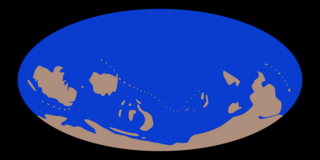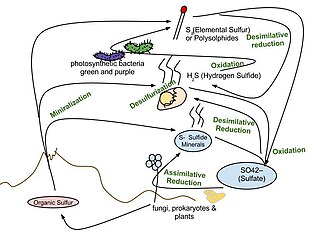
The Cambrian is the first geological period of the Paleozoic Era, and the Phanerozoic Eon. The Cambrian lasted 53.4 million years from the end of the preceding Ediacaran period 538.8 Ma to the beginning of the Ordovician Period 485.4 Ma.

The Eocene is a geological epoch that lasted from about 56 to 33.9 million years ago (Ma). It is the second epoch of the Paleogene Period in the modern Cenozoic Era. The name Eocene comes from the Ancient Greek Ἠώς and καινός and refers to the "dawn" of modern ('new') fauna that appeared during the epoch.

An extinction event is a widespread and rapid decrease in the biodiversity on Earth. Such an event is identified by a sharp fall in the diversity and abundance of multicellular organisms. It occurs when the rate of extinction increases with respect to the background extinction rate and the rate of speciation. Estimates of the number of major mass extinctions in the last 540 million years range from as few as five to more than twenty. These differences stem from disagreement as to what constitutes a "major" extinction event, and the data chosen to measure past diversity.

Approximately 251.9 million years ago, the Permian–Triassicextinction event forms the boundary between the Permian and Triassic geologic periods, and with them the Paleozoic and Mesozoic eras. It is Earth's most severe known extinction event, with the extinction of 57% of biological families, 83% of genera, 81% of marine species and 70% of terrestrial vertebrate species. It is also the greatest known mass extinction of insects. It is the greatest of the "Big Five" mass extinctions of the Phanerozoic. There is evidence for one to three distinct pulses, or phases, of extinction.

The Late Ordovician mass extinction (LOME), sometimes known as the end-Ordovician mass extinction or the Ordovician-Silurian extinction, is the first of the "big five" major mass extinction events in Earth's history, occurring roughly 445 million years ago (Ma). It is often considered to be the second-largest known extinction event just behind the end-Permian mass extinction, in terms of the percentage of genera that became extinct. Extinction was global during this interval, eliminating 49–60% of marine genera and nearly 85% of marine species. Under most tabulations, only the Permian-Triassic mass extinction exceeds the Late Ordovician mass extinction in biodiversity loss. The extinction event abruptly affected all major taxonomic groups and caused the disappearance of one third of all brachiopod and bryozoan families, as well as numerous groups of conodonts, trilobites, echinoderms, corals, bivalves, and graptolites. Despite its taxonomic severity, the Late Ordovician mass extinction did not produce major changes to ecosystem structures compared to other mass extinctions, nor did it lead to any particular morphological innovations. Diversity gradually recovered to pre-extinction levels over the first 5 million years of the Silurian period.

The Late Devonian extinction consisted of several extinction events in the Late Devonian Epoch, which collectively represent one of the five largest mass extinction events in the history of life on Earth. The term primarily refers to a major extinction, the Kellwasser event, also known as the Frasnian-Famennian extinction, which occurred around 372 million years ago, at the boundary between the Frasnian age and the Famennian age, the last age in the Devonian Period. Overall, 19% of all families and 50% of all genera became extinct. A second mass extinction called the Hangenberg event, also known as the end-Devonian extinction, occurred 359 million years ago, bringing an end to the Famennian and Devonian, as the world transitioned into the Carboniferous Period.

The important sulfur cycle is a biogeochemical cycle in which the sulfur moves between rocks, waterways and living systems. It is important in geology as it affects many minerals and in life because sulfur is an essential element (CHNOPS), being a constituent of many proteins and cofactors, and sulfur compounds can be used as oxidants or reductants in microbial respiration. The global sulfur cycle involves the transformations of sulfur species through different oxidation states, which play an important role in both geological and biological processes. Steps of the sulfur cycle are:

The Great Oxidation Event (GOE) or Great Oxygenation Event, also called the Oxygen Catastrophe, Oxygen Revolution, Oxygen Crisis or Oxygen Holocaust, was a time interval during the Earth's Paleoproterozoic era when the Earth's atmosphere and shallow seas first experienced a rise in the concentration of free oxygen. This began approximately 2.460–2.426 Ga (billion years) ago during the Siderian period and ended approximately 2.060 Ga ago during the Rhyacian. Geological, isotopic and chemical evidence suggests that biologically produced molecular oxygen (dioxygen or O2) started to accumulate in the Archean prebiotic atmosphere due to microbial photosynthesis, and eventually changed it from a weakly reducing atmosphere practically devoid of oxygen into an oxidizing one containing abundant free oxygen, with oxygen levels being as high as 10% of modern atmospheric level by the end of the GOE.
Anoxic waters are areas of sea water, fresh water, or groundwater that are depleted of dissolved oxygen. The US Geological Survey defines anoxic groundwater as those with dissolved oxygen concentration of less than 0.5 milligrams per litre. Anoxic waters can be contrasted with hypoxic waters, which are low in dissolved oxygen. This condition is generally found in areas that have restricted water exchange.

The clathrate gun hypothesis is a proposed explanation for the periods of rapid warming during the Quaternary. The hypothesis is that changes in fluxes in upper intermediate waters in the ocean caused temperature fluctuations that alternately accumulated and occasionally released methane clathrate on upper continental slopes. This would have had an immediate impact on the global temperature, as methane is a much more powerful greenhouse gas than carbon dioxide. Despite its atmospheric lifetime of around 12 years, methane's global warming potential is 72 times greater than that of carbon dioxide over 20 years, and 25 times over 100 years. It is further proposed that these warming events caused the Bond Cycles and individual interstadial events, such as the Dansgaard–Oeschger interstadials.
The Medea hypothesis is a term coined by paleontologist Peter Ward for a hypothesis that contests the Gaian hypothesis and proposes that multicellular life, understood as a superorganism, may be self-destructive or suicidal. The metaphor refers to the mythological Medea, who kills her own children.

The Cretaceous Thermal Maximum (CTM), also known as Cretaceous Thermal Optimum, was a period of climatic warming that reached its peak approximately 90 million years ago (90 Ma) during the Turonian age of the Late Cretaceous epoch. The CTM is notable for its dramatic increase in global temperatures characterized by high carbon dioxide levels.
The Cenomanian-Turonian boundary event, also known as the Cenomanian-Turonian extinction, Cenomanian-Turonian Oceanic Anoxic Event, and referred to also as the Bonarelli Event or Level, was an anoxic extinction event in the Cretaceous period. The Cenomanian-Turonian oceanic anoxic event is considered to be the most recent truly global oceanic anoxic event in Earth's geologic history. There was a large carbon cycle disturbance during this time period, signified by a large positive carbon isotope excursion. However, apart from the carbon cycle disturbance, there were also large disturbances in the ocean's nitrogen, oxygen, phosphorus, sulphur, and iron cycles.

Three Western Interior Seaway anoxic events occurred during the Cretaceous in the shallow inland seaway that divided North America in two island continents, Appalachia and Laramidia. During these anoxic events much of the water column was depleted in dissolved oxygen. While anoxic events impact the world's oceans, Western Interior Seaway anoxic events exhibit a unique paleoenvironment compared to other basins. The notable Cretaceous anoxic events in the Western Interior Seaway mark the boundaries at the Aptian-Albian, Cenomanian-Turonian, and Coniacian-Santonian stages, and are identified as Oceanic Anoxic Events I, II, and III respectively. The episodes of anoxia came about at times when very high sea levels coincided with the nearby Sevier orogeny that affected Laramidia to the west and Caribbean large igneous province to the south, which delivered nutrients and oxygen-adsorbing compounds into the water column.
Euxinia or euxinic conditions occur when water is both anoxic and sulfidic. This means that there is no oxygen (O2) and a raised level of free hydrogen sulfide (H2S). Euxinic bodies of water are frequently strongly stratified; have an oxic, highly productive, thin surface layer; and have anoxic, sulfidic bottom water. The word "euxinia" is derived from the Greek name for the Black Sea (Εὔξεινος Πόντος (Euxeinos Pontos)) which translates to "hospitable sea". Euxinic deep water is a key component of the Canfield ocean, a model of oceans during part of the Proterozoic eon (a part specifically known as the Boring Billion) proposed by Donald Canfield, an American geologist, in 1998. There is still debate within the scientific community on both the duration and frequency of euxinic conditions in the ancient oceans. Euxinia is relatively rare in modern bodies of water, but does still happen in places like the Black Sea and certain fjords.
The Toarcian extinction event, also called the Pliensbachian-Toarcian extinction event, the Early Toarcian mass extinction, the Early Toarcian palaeoenvironmental crisis, or the Jenkyns Event, was an extinction event that occurred during the early part of the Toarcian age, approximately 183 million years ago, during the Early Jurassic. The extinction event had two main pulses, the first being the Pliensbachian-Toarcian boundary event (PTo-E). The second, larger pulse, the Toarcian Oceanic Anoxic Event (TOAE), was a global oceanic anoxic event, representing possibly the most extreme case of widespread ocean deoxygenation in the entire Phanerozoic eon. In addition to the PTo-E and TOAE, there were multiple other, smaller extinction pulses within this span of time.
The Selli Event, also known as OAE1a, was an oceanic anoxic event (OAE) of global scale that occurred during the Aptian stage of the Early Cretaceous, about 120.5 million years ago (Ma). The OAE is associated with large igneous province volcanism and an extinction event of marine organisms driven by global warming, ocean acidification, and anoxia.
The Breistroffer Event (OAE1d) was an oceanic anoxic event (OAE) that occurred during the middle Cretaceous period, specifically in the latest Albian, around 101 million years ago (Ma).
The Paquier Event (OAE1b) was an oceanic anoxic event (OAE) that occurred around 111 million years ago (Ma), in the Albian geologic stage, during a climatic interval of Earth's history known as the Middle Cretaceous Hothouse (MKH).
The Amadeus Event (OAE1c) was an oceanic anoxic event (OAE). It occurred 106 million years ago (Ma), during the Albian age of the Cretaceous period, in a climatic interval known as the Middle Cretaceous Hothouse (MKH).







